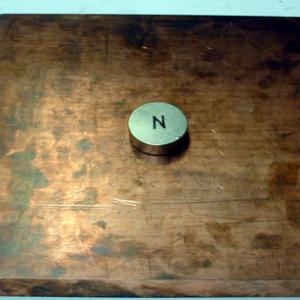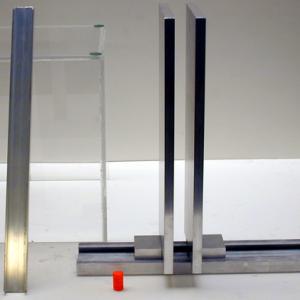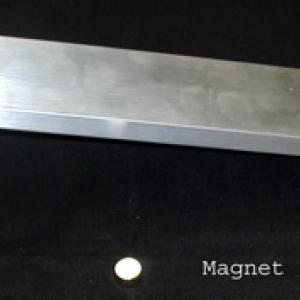College of Liberal Arts & Sciences
5K20.24 - Lenz's Law - Plates and Magnets
NOTE: Should you wish to clean the copper at any time to make it look new and shiny you can use a solution of: 2 parts Nitric Acid, 1 part Acetic Acid, and 1 part Phosphoric acid. Dip or wipe the copper with this solution and then rinse thoroughly with water.
Drop a 2 inch or 3 inch diameter magnet onto the copper plate from a height of about 6 inches. The magnet should float down to the plate without making any sound.
NOTE: Spinning the magnet will help keep it oriented parallel to the plate as it falls. Or, you can use a lazy suzan or the rotating air table to spin the plate while you drop the magnet.
Cooling the plate in liquid nitrogen will allow you to drop the magnet from a much greater height. It will also allow you to see the magnet bounce above the copper plate before it settles gently back down. When using the small plate for the cooling demonstration, the Plexiglas cylinder is needed to keep the magnet from falling off of the plate.
NOTE: The time required to cool the copper plate can be cut in half if the bottom side of the plate is smeared with a layer of vacuum grease.
The Eddy Current Guillotine is a cool way to demonstrate Lenz's law. With the magnets set at the top of the apparatus the copper plate will cut a red potato in half. Reposition the magnets down to the mark at the bottom and you can substitute your fingers for the potato with no danger due to the magnetic braking.
Large Eddy currents in silver may also be observed. Cool the coins in liquid nitrogen and then gently drop them onto the the magnet array as shown in the video below. Note that the large silver dollar coins work best for this demonstration.
Set the distance of the plates a little larger than the length of the magnet. Drop the magnet down through the plates and observe how it floats.
Take the 2"X10" aluminum plate and set one end on a block about 2 inches high. Roll a 1/4 thick X 1/2 inch diameter NIB down the plate and observe how the magnet likes to remain centered on the plate.
NOTE: Because the NIB is powerful enough to try to align itself in the Earth's magnetic field this demonstration works best when oriented in the East/West direction.
Set the "c" channel up at a fairly steep angle and drop a 4 magnet stack down the channel. The magnets should have a slight roll as they drop.
A single magnet may be placed flat on the "c" channel and the drop observed.
Another version of this demonstration consists of placing a piece of aluminum or copper plate in a pie tin, and floating this in a large pan of water. A neodymium magnet brought near the plate and moved around or rotated will show the induction that the magnet produces in the plate. See 5K20.42.
- James Lincoln, "Superconductors in the High School Classroom", TPT, Vol. 55, #8, Nov. 2017, p. 506.
- Chris Gaffney and Adam Catching, "Magnetic Viscous Drag for Friction Labs", TPT, Vol. 54, #6, Sept. 2016, p. 335.
- Michael Gore, "More Rolling Magnets", TPT, Vol. 43, #4, Apr. 2005, p. 248.
- Dragia T. Ivanov, "Another Way to Demonstrate Lenz's Law", TPT, Vol. 38, #1, Jan. 2000, p. 48.
- Wojciech Dindorf, "Lenz's Law in the Kitchen", TPT, Vol. 37, #5, May 1999, p. 268.
- Brian W. Holmes, "Money and Magnets", TPT, Vol. 35, #4, Apr. 1997, p. 212.
- Fernando G. Tomasel and Mario C. Marconi, "Rolling Magnets Down a Conductive Hill: Revisiting a Classic Demonstration of the Effects of Eddy Currents", AJP, Vol. 80, #9, Sep. 2012, p. 800.
- "B-287: Eddy Currents - Rotate Pie Pan - Nd Magnet Lift", DICK and RAE Physics Demo Notebook.
- Martin C. Sagendorf, "The Eddy Current Effect", Physics Demonstration Apparatus, 2009, p. 19 - 20.
- Borislaw Bilash II and David Maiullo, "Eddy Current Race", A Demo a Day: A Year of Physics Demonstrations, p. 310.
- Julien Clinton Sprott, "5.2, Eddy Currents", Physics Demonstrations, ISBN 0-299-21580-6, p. 213 - 215.
- Tap-L, "Comments of Doug Osheroff and Michael Thomason on the Copper Plate and Magnet Demo".
Disclaimer: These demonstrations are provided only for illustrative use by persons affiliated with The University of Iowa and only under the direction of a trained instructor or physicist. The University of Iowa is not responsible for demonstrations performed by those using their own equipment or who choose to use this reference material for their own purpose. The demonstrations included here are within the public domain and can be found in materials contained in libraries, bookstores, and through electronic sources. Performing all or any portion of any of these demonstrations, with or without revisions not depicted here entails inherent risks. These risks include, without limitation, bodily injury (and possibly death), including risks to health that may be temporary or permanent and that may exacerbate a pre-existing medical condition; and property loss or damage. Anyone performing any part of these demonstrations, even with revisions, knowingly and voluntarily assumes all risks associated with them.


